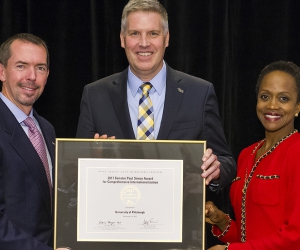
Reopening the Door: Toward Broadening Participation Through ATB at Community Colleges
Editor’s Note: This article was written by Raina Dyer-Barr, Jason A. Keist, Heather McCambly, and Eboni M. Zamani-Gallaher. It is the first article in the blog series “Advancing Equity through Ability to Benefit and College Promise Programs.” The series is part of the grant project A2B4Equity: Advancing Adults’ Ability to Benefit Through Equitable College Promise Programs.
There are scores of adults who fall in the ‘some college no degree’ category (Shapiro, Ryu, Huie, & Liu, 2019). Additionally, there are many adult learners who have not engaged in postsecondary study though they would benefit from higher education. Ability to Benefit (ATB/A2B) is a provision of the Higher Education Act (HEA) that expands federal financial aid access to adult learners who do not yet have a high school diploma or its equivalent. To be eligible for ATB, learners must demonstrate “college readiness” or the “ability to benefit from college” in one of three ways: 1) passing a United States Department of Education (USDE) approved standardized ATB test; 2) successfully attaining six college credit hours (without financial aid assistance); 3) or enrolling in a state-approved ATB career pathway process or plan. The postsecondary institution must also demonstrate that it has created a career pathway program to support these learners to success. Essentially, ATB offers an alternate path to federal student aid for adult learners enrolled in “eligible career pathway programs” without first obtaining a high school diploma, subsequently expanding access to accelerated postsecondary education and employment opportunities for an underserved population.
Many community colleges offer or partner with Adult Basic Education (ABE) or Integrated Education and Training (IET) programs and services that provide adult learners access to basic skills, literacy, English proficiency, and workforce preparation and training opportunities. Community colleges have also demonstrated a unique ability to serve adult learners well via a range of services, supports, and programs specifically geared toward accelerating their entrance and completion of other meaningful postsecondary and workforce credentials, subsequently advancing this population’s ability to seek employment with family sustaining wages. Therefore, a robust integration of ATB on community college campuses presents a prime opportunity to further advance and accelerate adult learners’ postsecondary credential attainment and entry into the workforce by utilizing existing career pathway programs at these institutions. The alignment of ATB with existent community college career pathway programming is particularly relevant and worth consideration given that the guidelines that circumscribe “eligible ATB career pathway programs” are well-aligned with Perkins V and the Workforce Innovation and Opportunity Act (WIOA), both of which community colleges are already intimately familiar and have already established many WIOA partners available to work with to support the postsecondary success of adult learners.
ATB and Equity
Widespread implementation and integration of ATB in community colleges has the potential to contribute to broader efforts to address persistent equity gaps in postsecondary access, credentialing and completion, as well as employment and income. In 2020, nearly 25% of adults living in poverty lacked high school credentials (AACC, 2021) and almost 9% of adults over 25 had no high school diploma or equivalency (US Census Bureau, 2022). Utilizing ATB could allow community colleges to serve more adult learners and could also play a critical role in credentialing and employment and wage gaps among this already underserved population – which tends to be comprised largely of racially minoritized and other marginalized adults. ATB has the potential to benefit community colleges directly. With the onset of the COVID-19 pandemic, enrollments dropped across all postsecondary contexts. Community colleges have experienced particularly significant impact of the pandemic, with enrollment declining by more than 13% (Geary, 2022). Tapping adult learners via robust and effective community college ATB offerings, could help community colleges begin to increase programmatic and institutional enrollments, especially among those institutions struggling to recover as the pandemic ebbs.
A New Project: A2B4Equity
The Corporation for a Skilled Workforce (CSW) in collaboration with University of Pittsburgh School of Education researchers and the World Education National College Transition Network, have launched a new project to expand ATB use at community colleges. A2B4Equity: Advancing Adults’ Ability to Benefit Through Equitable College Promise Programs (A2B4Equity) is funded by ECMC Foundation and aims to leverage already established college promise programs offered at participating colleges to support adult learners who aspire to earn a college credential but who have yet to attain an HSD or HSE. Students must have already earned an HSD or HSE to be eligible for most college promise programs. This project will pilot an alternative: using proxy college promise funding as “first dollar” financial support for students without a HSD or HSE to earn six hours of college credit in ATB-eligible pathway programs and gain access to federal student financial aid. After students have earned these first six credits, they will be eligible to access federal financial aid dollars to complete their academic program and will also continue to be supported by college promise funding at their host college.
Four community colleges in total will be selected to implement the A2B4Equity pilot. The City Colleges of Chicago (CCC) Chancellor’s Office will identify two colleges who house integrated Career Bridge programs to pilot this project, and an additional two Michigan colleges will be chosen by the Michigan Department of Labor and Economic Opportunity (LEO) to incorporate ATB requirements within the states’ existing Michigan Reconnect and Futures for Frontliners college promise programs. At the conclusion of the project, it is expected that participating colleges in both states will maintain pilot-initiated eligibility standards for future incoming ATB students.
Equity Conscious Learning for the Community College Field
As a research team, we will approach this work with a two-pronged concern united by a central interest in the potential of ATB to reduce racialized barriers to accessing community college coursework and financial aid – an apt uneasiness given that racially minoritized students are disproportionately prevented from accessing aid without ATB pathways. First, we will monitor and share with the field student-focused outcomes, including disaggregated measures of student success in funded ATB coursework and students’ success securing post-ATB financial aid which will speak to the efficacy of using college promise funds for ATB pathways. And second, taking a collaborative research approach with implementation sites, we want to understand what it takes to implement ATB with an eye toward equitable outcomes – e.g., what do student recruitment and advising, wrap-around services, coordination with Promise scholarship programs, and transition services need to look like to ensure equitable experiences and outcomes at every step of the way? CSW will be authoring a “how-to” guide to help other community colleges understand how to implement the six-credit ATB option based on learnings from this pilot.
For context, new policies or programs, like ATB for Equity, with the potential to reduce racialized barriers are often subverted, however unintentionally, as they meet the constraints of systems designed historically to be white serving (McCambly & Colyvas, 2022; Ray et al, 2022; Welton, Owens, & Zamani-Gallaher, 2018). For example, deficit-minded approaches to implementing an ATB program could undermine the services and advising offered to students of color in ways that reproduce status quo by creating heightened administrative burdens or producing messaging to students–that they are not welcome or don’t belong in the college setting. We hope to better understand these contingencies in ways that will provide insights and models for community colleges looking to bring this systemically underserved population equitably into the full fold of participation to foster greater student mobility.
References
American Association of Community Colleges (AACC). (2021, October 26). DataPoints: Education, income and poverty. https://www.aacc.nche.edu/2021/10/26/datapoints-education-income-and-poverty/
Geary, C. (2022, January 25). Community college enrollment declines threaten to worsen educational inequity. New America. https://www.newamerica.org/education-policy/edcentral/community-college-enrollment/
McCambly, H., & Colyvas, J. A. (2022). Dismantling or disguising racialization? Defining racialized change work in the context of postsecondary grantmaking. Journal of Public Administration Research and Theory. https://doi.org/10.1093/jopart/muac021
Ray, V., Herd, P., & Moynihan, D. (2022). Racialized burdens: Applying racialized organization theory to the administrative state. Journal of Public Administration Research and Theory, muac001. https://doi.org/10.1093/jopart/muac001
Shapiro, D., Ryu, M., Huie, F., & Liu, Q. (2019, October). Some college, no degree: A 2019 snapshot for the nation and 50 states, Signature Report No. 17. National Student Clearinghouse Research Center. https://nscresearchcenter.org/wp-content/uploads/SCND_Report_2019.pdf
U.S. Census Bureau. (2022, February 24). Census Bureau releases new educational attainment data [Press release]. https://www.census.gov/newsroom/press-releases/2022/educational-attainment.html
Welton, A. D., Owens, D. R., & Zamani-Gallaher, E. M. (2018). Anti-racist change: A conceptual framework for educational institutions to take systemic action. Teachers College Record, 120(14), 1-22.




